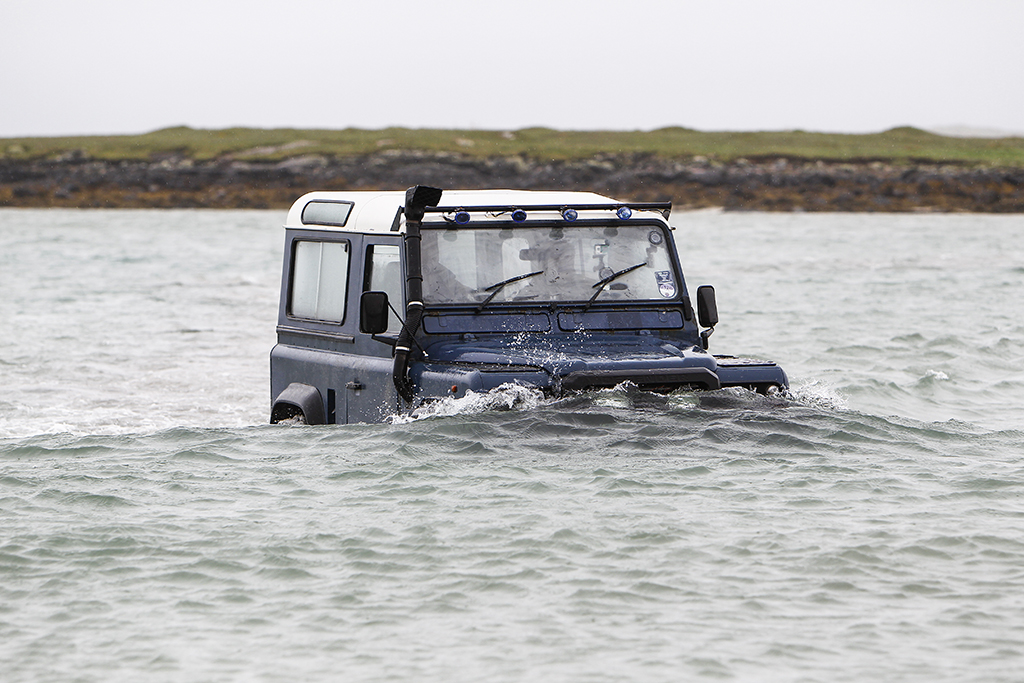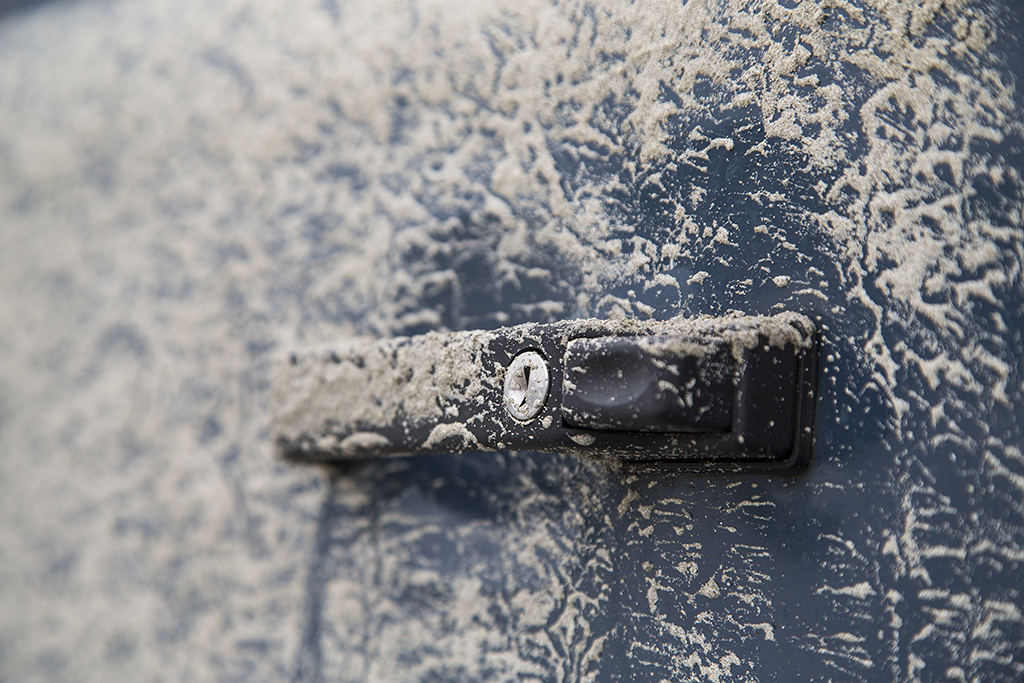
Testing the Land Rover Defender in Scotland’s waters
After a run of 67 years in production, making the Land Rover Defender came to an end on January 2016.
We turned back the clock, to when the Scotsman’s best friend was put on test in a watery playground.
My right foot’s planted but the engine note drops to a dull, sickening groan. It’s walking the tightrope between life and death.
With saltwater lapping over the bonnet, we’ve a mile of North Atlantic swilling behind us, and the same ahead.
Our Land Rover Defender 90 has tussled, grappled and bludgeoned its way across 216,000 miles during its 20-year life, but this could be its last.
Just as Ford markets its Transit as the ‘backbone of Britain’, the same could be said of the original Land Rover and Scotland. In 1947, prototypes were tested on Islay, where Rover boss Spencer Wilks owned an estate, and while Land Rovers have served the world over, nowhere are they more at home than in Scotland: dirtied, worked and depended-upon.
But after 67 years and two million cars built, the Defender (as it’s been called since 1990) is on the brink. The old formula has barely changed – the only major advances being coil-sprung suspension, front disc brakes and turbocharging – and now safety and emissions pressures mean its time is up. A replacement is expected around 2018, but it will be a very different, modern beast.

The now retired Land Rover Defender (Photo: Richard Webber)
So how to say farewell? With an off-road challenge, of course. Land Rovers have driven as far above sea level as is possible in Scotland, scaling Ben Nevis’s 1344 metres more than once. But our target was quite the opposite: to go more than a metre below sea level.
The run-out special edition ‘Autobiography’ Defender boasts the likes of contrast-stitched leather seats, air-conditioning and a fancy stereo (as it should for £61,845). But we didn’t need any of that – just the go-anywhere grit that has come as standard since 1948 – hence our ‘pre-loved’ Defender 90, approximate value, £5,000. Its light blue paintwork has been tousled by 20 Scottish winters, some of which were spent tramping across Skye according to one of its numerous stickers.
Others tell of Land Rover club membership – a sign the car has been equally cherished and chastised.
Our challenge will take place on North Uist in the Outer Hebrides – the edge of Scotland, the edge of Europe. The drive from Edinburgh is blessed with glorious June sunshine that illuminates glens, beaches and lochs before setting a Turkish Delight pink as we wind through Skye’s haunting, jagged Quiraing towards an overnight stop at Flodigarry.
Day two’s ferry takes us to Harris, where we stop to see Donald John Mackay MBE, who is weaving Harris Tweed (for Chanel, as it happens) in his shed overlooking Luskentyre’s butter-coloured sands. We pause in Northton for a lunch of lobster and fresh bread from Croft 36’s honesty shack and pluck mussels at Finsbay before catching another ferry, which treats us to the sight of a huge, limo-length basking shark.
The city couldn’t feel further away as we land at Berneray, and the Defender fits right in: mistaking us for busy farmers, other road users dive out of our way where they would bemoan our lack of pace on the mainland.

The water level is more than double Land Rover’s stated wading limit (Photo: Richard Webber)
We totter into Botarua on North Uist’s west coast and meet our local contact, the bearded, friendly and convincingly weather-beaten Angus MacDonald. Two miles across the bay we see our goal, Vallay – a 650-acre island that’s home to nothing but Angus’s highland cattle.
But at low tide, the crossing on bare sand would be child’s play for the Defender, so we retire to sample some prized Vallay beef, and wait…
The next morning is dull, dank and cold. The inviting sands to Vallay have been replaced by a restless tranche of North Atlantic, and depth markers reveal the water is around 1.2 metres deep. The Defender’s stated wading limit is 0.5 meters. But Land Rover must have engineered-in a healthy tolerance. Surely. Surely?
The Defender’s optional ‘snorkel’ is designed to keep dust out of the turbodiesel engine’s air intake, but we’re hoping it’s watertight, too, or the engine will ingest water and catastrophically fail. Otherwise, the car is as it left the Solihull factory in 1995. At 113bhp, it produces less power than a mid-range Ford Fiesta, and scarcely more torque, but low range and a differential lock will make best use of the meagre shove available.
The other danger is patches of gloopy sand that could swallow our wheels, but having Angus on board will help us navigate around them. We fire up the noisy old engine and wade into the churning sea. Up to the half-metre mark, the Defender is comfortable. The steering gets heavier, but in third gear and low range we cut along quite nicely, albeit the sound of splashing and sight of water in all directions – with our photographer bobbing alongside in a dinghy – is unsettling at best.
As the sea rises I slow a little to keep the all-important bow wave just ahead of us. This carves out pockets of air down our flanks, keeping water out of the cabin. Lose momentum or turn too sharply and that protective shield will dissipate, leaving us pickled in brine like a pair of helpless gherkins. If we start to float, we’ll have to flood the cabin on purpose to regain traction and hope the engine hangs on.

The Defender’s salt and sand encrusted door handle (Photo: Richard Webber)
Passing the metre mark, the bow wave becomes a roller that rises above bonnet-level and fans into a huge arc behind us. Squalls whip the wave crest up then hurl it into the flat windscreen. The wipers can’t keep up, and opening a window to clear the fogging interior brings a faceful of spray.
Around the halfway mark, we have to thread through some islets, momentarily turning us against the tide. A stationary cubic metre of water – let alone one being pushed by the tide – weighs a metric ton, so the forces the Defender has to work against shoot up. As the bow wave compresses against our grille, the engine really starts to strain and I rush a downshift to preserve momentum. Angus looks worried.
And he’s not a man who seems given to worry. Unexpectedly, the water rises yet again and we have to turn sharply, surrendering our bow wave. Which is when the bonnet gets swamped and the engine note dips again. My heart plunges. Angus curses. We’re silently begging the crankshaft for just a few revolutions more to keep us moving, or it’s curtains. To our huge relief, the old workhorse digs in, not one horsepower spared. With the tide in our favour once more, we’re back up to speed, the engine healthily roaring away.
As Vallay’s shores rise to meet us, the bow wave melts into rumbling white water, our wheels kicking up triumphant rooster tails. Climbing onto terra firma, the headlights are half-filled with water like little goldfish bowls, but our feet are – incredibly – bone dry. Our Defender had just spanned the toughest pair of its 216,000 miles, but faced them with the same characteristic relentlessness that defines its breed.
All that remains is a short amble across Vallay’s machair and a rock-crawl down onto a deserted white beach. With nothing but Atlantic Ocean between us and Nova Scotia, we’ve reached journey’s end. What a place to say goodbye. And what a car to have taken us there.
(This feature was originally published in 2015)
TAGS

